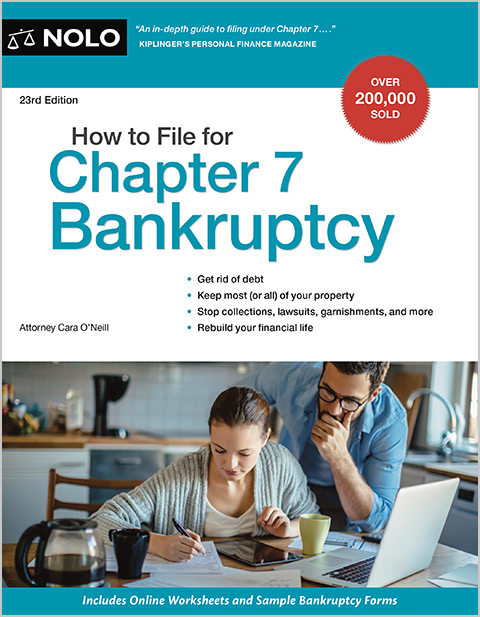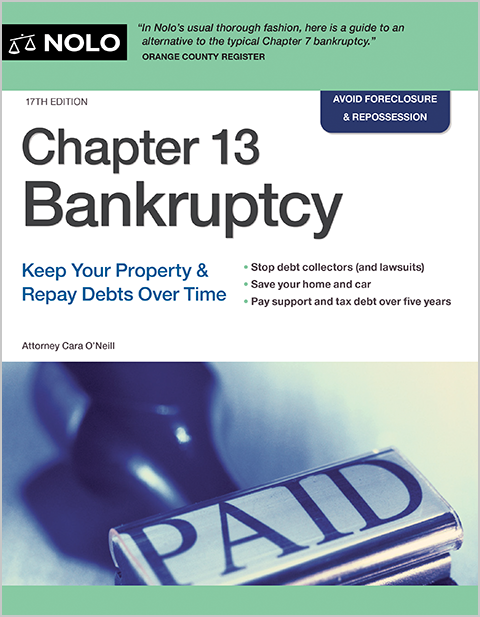Learn about the calculation of a monthly Chapter 13 plan payment.
The hallmark of a Chapter 13 bankruptcy case is the repayment plan you'll propose to the bankruptcy trustee, creditors, and the court. To a significant degree, three factors will determine your Chapter 13 plan type and monthly payment amount:
- your disposable income (the amount remaining after subtracting allowed expenses)
- the nondischargeable debts you must pay in full through your plan, and
- the value of assets you can't protect with an exemption.
A debtor whose income doesn't exceed the state's median income can submit a three-year plan. All others must last five years.
- How Long Is a Chapter 13 Bankruptcy Plan?
- How Much Will I Pay in a Chapter 13 Bankruptcy Plan?
- Can I Afford to Pay Priority Nondischargeable Debt in a Chapter 13 Plan?
- How Much Must My Chapter 13 Plan Pay Nonpriority Unsecured Creditors?
- When You Must Pay for Property in a Chapter 13 Bankruptcy Plan
- How to Calculate the Amount You Must Pay For Property (If Anything)
- Applying All Factors in a Chapter 13 Plan
- What Will Happen After I Complete My Chapter 13 Plan?
- Talk to a Chapter 13 Bankruptcy Lawyer
- Need More Bankruptcy Help?
How Long Is a Chapter 13 Bankruptcy Plan?
Most Chapter 13 filers pay into a five-year plan. However, if your gross income doesn't exceed your state's median income amount, you'll qualify for a three-year plan.
The calculations below apply to people using a five-year plan. People paying into a three-year plan have more flexibility because they can use actual monthly expenses.
How Much Will I Pay in a Chapter 13 Bankruptcy Plan?
If you're paying into a five-year Chapter 13 repayment plan because you don't qualify for a shorter three-year plan, you'll need to be able to pay your monthly living expenses, including your house and car payment if you plan to keep them.
You must also pay the following in full:
- mortgage and car loan arrearages, and
- priority debt balances, such as domestic support obligations and most overdue tax debt.
But that's not all. Most people must pay whatever amount remains after paying those amounts, known as "disposable income," toward any remaining debt, such as medical balances, utility bills, personal loans, and credit card bills. These creditors falling in the lowest payment category are known as nonpriority unsecured debts.
Can I Afford to Pay Priority Nondischargeable Debt in a Chapter 13 Plan?
Recently incurred tax debt and domestic support obligations are examples of priority debt that you must pay in full through the plan. When people fall behind on these debts, they often accumulate quickly, leaving many filers to pay thousands of dollars in a Chapter 13 plan.
If you can't afford to do so, the judge won't "confirm" or approve your plan. This factor and the requirement to pay to keep nonexempt property (discussed below) often derail a filer's ability to propose a feasible Chapter 13 plan the judge will approve.
How Much Must My Chapter 13 Plan Pay Nonpriority Unsecured Creditors?
To determine your disposable income, you'll subtract actual and predetermined expenses from your income. In most cases, these deductions will include:
- mortgage or rent
- car payment and maintenance costs
- allowed (not actual) food, clothing, and utility expenses
- monthly tax and support obligations, and
- childcare costs.
The remaining amount is disposable income you must pay to unsecured creditors. It's distributed on a pro-rata basis with each nonpriority unsecured creditor receiving a portion equal to its percentage of overall debt.
This is a simplified explanation. To determine your disposable income, you'll want to learn the differences between secured, priority, and unsecured debt and consider completing Chapter 13 Calculation of Your Disposable Income (Form 122C-2) or speak with a bankruptcy lawyer.
When You Must Pay for Property in a Chapter 13 Bankruptcy Plan
You don't lose property in Chapter 13. However, this benefit can be costly. To ensure your creditors receive equal treatment in Chapters 7 and 13, you must pay creditors at least as much as they would have received if you had filed for Chapter 7.
Determining how much that would be isn't as hard as it sounds. It's the value of your nonexempt property (assets that aren't protected by a bankruptcy exemption) minus the amount it would cost to sell the property.
Learn about keeping property in Chapter 13 bankruptcy.
How to Calculate the Amount You Must Pay For Property (If Anything)
All bankruptcy filers can protect or "exempt" a certain amount of property in a bankruptcy case. The debtor's state decides the type and value of exempt property and maintains lists in its exemption statutes.
Nonexempt property, which is anything you can't protect in a bankruptcy case, must be either:
- sold for the benefit of creditors in a Chapter 7 case, or
- the value must paid to nonpriority unsecured creditors in a Chapter 13 repayment plan (minus liquidation costs).
Example. Jesse's monthly payments on $50,000 of unsecured credit card debt were more than he could pay each month, so he wanted to file for bankruptcy. His primary asset was a vacation home worth $200,000 that he owned outright. He consulted with an attorney and found out that his state, like all others, didn't offer an exemption covering the property, leaving all $200,000 nonexempt.
If Jesse filed for Chapter 7 bankruptcy, the bankruptcy trustee would sell it, pay off all creditors, deduct the trustee's fee, and return the remaining balance to Jesse. Because all creditors would get paid fully in Chapter 7, if Jesse wanted to file for Chapter 13 and keep the property, he would have to repay all of his unsecured creditors in full over five years.
Applying All Factors in a Chapter 13 Plan
These three factors—your disposable income, nondischargeable debt, and the amount of your nonexempt property—will determine the Chapter 13 monthly amount you'd pay. You can come up with a close approximation using these factors, but you should consult with a bankruptcy lawyer for an accurate amount.
- Typical repayment plan. Most debtors have some funds remaining after deducting allowed expenses from their income; however, the disposable income amount remaining for unsecured creditors is often relatively small (which is why some people claim that you can "pay pennies on the dollar in bankruptcy"), but not always.
- 0% repayment plan. Sometimes the debtor won't have any discretionary income to pay to unsecured creditors and no nonexempt property. Typically, such debtors qualify for Chapter 7 bankruptcy but file for Chapter 13 bankruptcy to save property. In courts that allow these types of plans, a debtor can use a Chapter 13 bankruptcy to bring current an overdue mortgage or car payment and pay nothing to unsecured creditors. Even so, the debtor will still receive a discharge for qualifying unsecured debt (such as credit card balances) at the end of the repayment plan. (Learn more in What Is a Bankruptcy Zero Percent Plan?)
- 100% repayment plan. When a debtor's nonexempt property exceeds the total amount of unsecured debt, and the debtor wants to keep all of the property, the debtor will likely have to repay 100% of the debt.
The percentage a debtor must pay unsecured creditors is often used as shorthand between bankruptcy attorneys and court staff to describe the plan. For example, "Ashley is paying into a 17% plan."
What Will Happen After I Complete My Chapter 13 Plan?
Most people exit Chapter 13 debt-free except for long-term debt that doesn't qualify for a discharge, such as a mortgage (if you keep your house) and student loans. Even though student loans get paid with other unsecured debt—which will likely reduce your payment during the plan period—you'll remain responsible for any remaining balance after the case closes.
Also, Chapter 13 could invalidate your income-contingent student loan plan, so be sure to explore the possible effects with a bankruptcy attorney and your student loan servicer.
Talk to a Chapter 13 Bankruptcy Lawyer
This article's purpose is to provide general Chapter 13 plan information. Given that this bankruptcy chapter is especially complicated, potential filers are strongly encouraged to retain a bankruptcy lawyer.
Need More Bankruptcy Help?
Did you know Nolo has been making the law easy for over fifty years? It's true—and we want to make sure you find what you need. Below you'll find more articles explaining how bankruptcy works. And don't forget that our bankruptcy homepage is the best place to start if you have other questions!
|
Our Editor's Picks for You |
|
|
More Like This |
Should I File Chapter 7 or 13 to Keep My House? Chapter 13 Bankruptcy Overview |
|
Other Articles You Might Like |
How to File for Bankruptcy in Your State |
|
Helpful Bankruptcy Sites |
We wholeheartedly encourage research and learning, but online articles can't address all bankruptcy issues or the facts of your case. The best way to protect your assets in bankruptcy is by hiring a local bankruptcy lawyer.
- How Long Is a Chapter 13 Bankruptcy Plan?
- How Much Will I Pay in a Chapter 13 Bankruptcy Plan?
- Can I Afford to Pay Priority Nondischargeable Debt in a Chapter 13 Plan?
- How Much Must My Chapter 13 Plan Pay Nonpriority Unsecured Creditors?
- When You Must Pay for Property in a Chapter 13 Bankruptcy Plan
- How to Calculate the Amount You Must Pay For Property (If Anything)
- Applying All Factors in a Chapter 13 Plan
- What Will Happen After I Complete My Chapter 13 Plan?
- Talk to a Chapter 13 Bankruptcy Lawyer
- Need More Bankruptcy Help?

